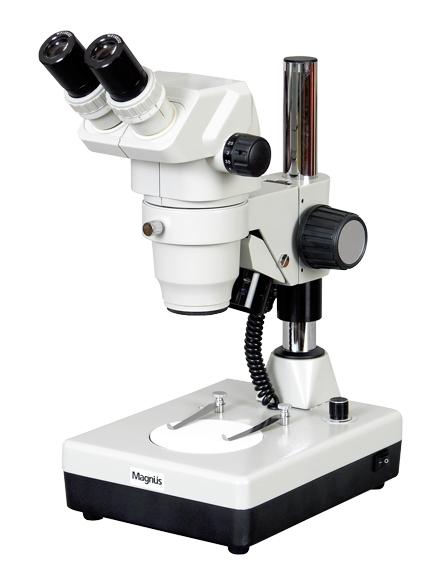Explore High-Performance Microscopes at Magnus Opto
Magnus Opto is a trusted name in precision optics, offering a comprehensive range
of high-quality microscopes tailored to diverse scientific, medical, industrial, and educational needs.
Whether you're looking for sophisticated imaging solutions for laboratory research or user-friendly designs
for classroom settings, our lineup is engineered to deliver clarity, durability, and performance.
At Magnus Opto, we understand that choosing the right microscope is essential for
accurate analysis and enhanced productivity. That’s why we offer a broad selection of microscopes, including
Compound Microscopes, Inverted Microscopes, Stereo Microscopes, Teaching Microscopes, Phase Contrast
Microscopes, Fluorescence Microscopes, and Digital Microscopes.
Types of Microscopes :-
Compound Microscopes: Precision and Clarity for Lab Excellence
Our Compound
Microscopes are ideal for high-resolution examination of
biological specimens. These microscopes are widely used in medical laboratories, universities, and research
facilities. With multiple objective lenses and high magnification capability, they provide detailed
visualization of cells, bacteria, and tissue structures.
Magnus Opto’s compound microscopes offer ergonomic design, superior optics, and
long-lasting build quality—perfect for both routine laboratory work and advanced research
applications.
Inverted Microscopes: Ideal for Cell Culture Studies
Designed specifically for observing specimens in petri dishes or culture
flasks,
Inverted Microscopes are an essential tool in cell
biology and tissue engineering. At Magnus Opto, our inverted microscopes deliver exceptional contrast and
resolution, making them suitable for live cell imaging and time-lapse observations.
Equipped with user-friendly controls and robust construction, these microscopes
streamline workflows in clinical and research laboratories.
Stereo Microscopes: 3D Visualization for Inspection and Dissection
Our Stereo
Microscopes offer three-dimensional views of larger
specimens, making them ideal for dissection, industrial inspection, and educational demonstrations. They
feature low magnification and long working distances, allowing for manipulation of the sample while
viewing.
Magnus Opto’s stereo microscopes deliver crisp images, excellent depth
perception, and intuitive operation—suitable for quality control, forensic analysis, and PCB inspection
tasks.
Teaching Microscopes: Designed for Educational Excellence
Education forms the foundation of scientific progress, and our Teaching
Microscopes are designed to inspire and educate the next
generation of scientists. With robust construction and easy operation, these microscopes are perfect for
schools, colleges, and training institutions.
Magnus Opto’s teaching microscopes combine durability with high optical
performance, ensuring that students gain hands-on experience with reliable, real-world instruments. Many
models also offer multi-viewing capabilities for guided instruction and collaborative learning.
Phase Contrast Microscopes: Enhanced Visualization of Transparent Samples
For researchers working with unstained, transparent specimens like live cells or
thin tissue slices, Phase
Contrast Microscopes provide the contrast needed without the use of dyes. At Magnus
Opto, our phase contrast systems use specialized optics to amplify subtle differences in light transmission,
making internal structures more visible and detailed.
These microscopes are essential in cell culture studies, microbiology, and
pathology—offering high-contrast, distortion-free imaging even for difficult samples.
Fluorescence Microscopes: Unlock the Secrets of Cellular Function
Fluorescence microscopy has revolutionized biological imaging, allowing
scientists to track cellular processes in real time. Our
Fluorescence Microscopes are engineered for high-sensitivity detection of
fluorescent signals in cells, tissues, and microorganisms.
Ideal for molecular biology, immunology, and genetic research, Magnus Opto’s
fluorescence microscopes combine bright LED illumination, advanced filter systems, and cutting-edge optics
to deliver high-resolution fluorescence imaging with minimal background noise.
Digital Microscope: Seamless Integration with Modern Workflows
In today's digital world, microscopy needs to be faster, smarter, and more
connected. Magnus Opto's
Digital Microscope brings modern technology to the forefront of scientific
observation. With built-in digital cameras and USB or HDMI connectivity, these microscopes enable direct
image capture, sharing, and analysis on computers and displays.
Perfect for documentation, remote teaching, and real-time collaboration, our
digital microscopes streamline microscopy in both research and industrial environments.
Why Choose Magnus Opto for Your Microscopy Needs?
- Precision Optics: Every microscope is built with
high-quality optics for superior image clarity and contrast.
- Durability: Our instruments are made to withstand
intensive daily use, ensuring long-term performance.
- User-Centric Design: Whether you're a student,
technician, or researcher, our ergonomic designs make microscope usage efficient and comfortable.
- Wide Range: From basic teaching models to advanced
research-grade systems, Magnus Opto has a solution for every application.
Conclusion
Microscopes are essential tools that empower scientists, educators, and industry
professionals to explore and understand the microscopic world. At Magnus Opto, we are proud to offer a full
spectrum of microscopes, including Compound, Inverted, Stereo, Teaching, Phase Contrast,
Fluorescence, and Digital Microscopes, tailored to meet your unique
needs.
Explore our full range of microscopes and experience the Magnus
Opto advantage—where innovation meets precision. Whether you're enhancing your classroom, upgrading a
research lab, or optimizing industrial inspection, our microscopes are your trusted partner in
discovery.
FAQs
1. What is the difference between a compound microscope and a stereo
microscope?
A compound microscope uses multiple lenses to achieve high
magnification and is ideal for viewing small, thin specimens like cells and microorganisms. In contrast, a
stereo microscope provides a 3D view of larger, solid objects at lower magnifications,
making it perfect for tasks like dissection and quality inspection.
2. When should I use an inverted microscope instead of a traditional compound
microscope?
Inverted microscopesare best suited for observing living cells
in culture dishes or flasks, as they have the light source and objective lenses positioned below the stage.
This design makes them ideal for cell culture studies, unlike compound microscopes, which
are used for viewing slides from above.
3. What are the advantages of using a digital microscope?
A digital microscope allows users to view, capture, and share
images on a monitor or computer in real time. It's ideal for documentation, remote teaching, quality
assurance, and research collaboration. Magnus Opto’s digital microscopes combine advanced optics with modern
connectivity for streamlined workflows.
4. Are teaching microscopes suitable for college-level biology labs?
Yes. Magnus Opto’s teaching microscopes are designed to meet the needs of both
schools and higher education institutions. They offer high-quality optics, durability, and features like
multi-viewing heads, which are ideal for collaborative learning in classrooms and laboratories.









